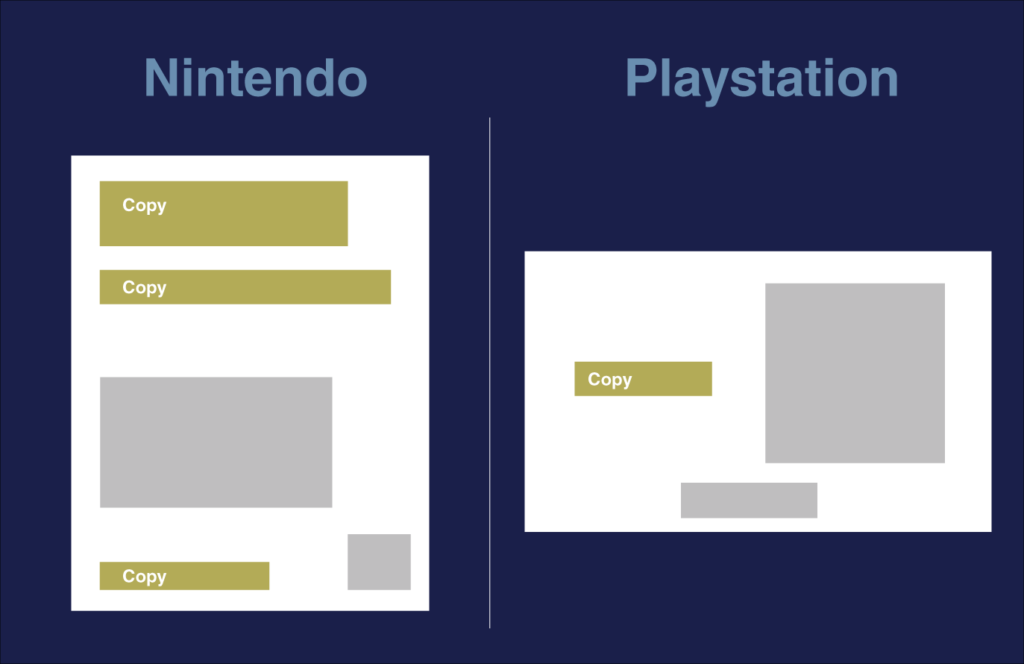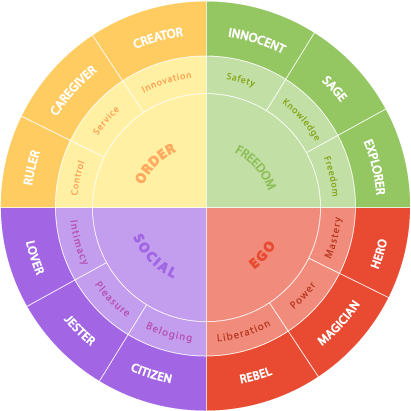Copywriting is the way you make the consumer aware and alert about your product or service through the art of building blocks of words while considering the brand tone and positioning.
When I mention building blocks, I am talking about a great variety of structures, including onomatopoeias, interjections, paragraphs, whole sentences, or even a single word.
Here some examples:

Smart use on space and size. Background color is used for the branding.

An insight collected by UTZ and used in its copywriting.

In this copy they used the Mexico landscape and syncretism to create a different campaign.
Everything will depend on who your audience is and how you want to engage them. You must also consider the competition and what they are doing or better said ‘saying.’ In every case, a great copywriting piece must lead to action, because we don’t want the consumer only reflects about it but also be part of it.
Copywriting meets its destination -the potential client- together with the graphic design and the proper collateral.
Take note that when we are talking about graphic design, we also are talking about the presence of typography; while when we are discussing collateral, we are emphasizing where the ad is going to be displayed.

Typography always highlights the purpose of the copywriting. Size, color and position play this role.
How to create great copywriting is the column of every advertising piece -an absence of copy in an ad also delivers meaning-, and you must know how to create it. Here I will show you how to produce your own and what tools you can use to excel on it.
Three, two, write.
Contrary to the common thought copywriting must do more with recollecting background information about the brand and your competition than to be creative. I know this might sound controversial-, but remember that advertising is competition in its most civilized form -besides sports- and we are creating a copy because we want customers, not only fans.
The first thing to do is to know the brand and what is the feeling or tone we want to project. Some brands struggle with this idea because they believe the consumers are zombies who will go after the first sight of movement or noise, but this is not true. This attitude also reveals a lack of marketing knowledge and customer behavior.

Market investigation is essential for a successful copy. Insights, habits, and vocabulary are gathered here.
Consider that every copy needs to cling into something of value, something that your brand is good at and does effectively. In case you have a service, ask yourself: How can I present my services to my target?
Answer: Not only say you do something but also how you do it, which means you need to provoke a reaction. So basically, you are stimulating the client with words.
Creating bars
First, you need to find out the feeling or tone of your brand. Check out this example from PlayStation and Nintendo.

The Nintendo copy feels friendly and open to welcome anybody.

Straight and aggresive the Playstation copy feels different than Nintendo’s. Even the color is more intense.
Nintendo aims to gamers who prefer portability plus more user-friendly haptics, while PlayStation is more aggressive and straight forward: ‘You need to know how to play to use a PlayStation.’
These products also differ in design which the copywriting highlights through positioning, while Nintendo puts it on top, PlayStation aligns the picture next to the text.

The layout also differs from brand to brand. One is direct and sober while the other more descriptive.
Therefore, to find your feeling, you need to remember how you ‘talk’ to your customers about your products.
Many times, without noticing we choose to talk using some aspects like: ‘I deliver my products in this way…’, ‘this is the reason why I created this product,’ among other 40 second speeches we use to persuade our buyers.
Gather all those stories, reasons, and one-liners and choose the collateral where you are going to place it.
Remember, the collateral also interacts with the medium: print, video, or digital. Therefore, you must take all these elements into account every time you create a copywriting piece. Here is an example on how copy is shown in websites.
Sometimes there are certain words that a brand might use to gain positioning. The creatives might use this word every time they want to build a new copy because it triggers a feeling in the target.
One of the most popular copywriting pieces that used this resource was Pepsi with the phrase ‘New Generation.’

Pepsi has used the ‘New Generation’ copy for years.
Now and then, Pepsi still uses the phrase ‘New Generation’ to remind people about its brand tone and feeling. However, it has become more repetitive and boring after so many years.
Remember that if you do not find your feeling, your copy is not going to differentiate from the competition, and you might invite your rivals to enter a price war indirectly, which is not the best way to get customers.
So, let’s do an exercise and learn how to create a great copywriting for a new product. Let’s say we are going to sell weights.
First, we need to define who we are selling these weights: gyms, individual customers, nursing homes, or hospitals (for rehabilitation purposes). Maybe it is one of them, or perhaps we have enough resources to target all those audiences. However, targeting all doesn’t mean we will use the same copy for all of them.
So, let’s create one for nursing homes because it seems more challenging.
Finding the feeling
Now we must pay attention to the positioning of the brand. So, I ask you: You have your positioning ready, right? If you answer yes, then you are in good shape, but if you don’t, then you need to create one ASAP.
Now, many small and medium enterprises won’t take enough planning time to determine what their positioning is, so if you are a marketing manager or an advertising agent, you need to talk with the production department and gather info.
In this case, let’s assume the production department has told us their weights and exercise tools include a fabulous grip and an anatomical design for a better fit. We also know the weights include a titanium alloy, plus you can choose a color from a palette of four. Finally, we get the product name is ‘Big Boy Weights and Exercise Tools.’
Choosing the archetypes
Now have in mind you must choose among the archetypes of a brand. Here there is a wheel you can use to define what kind of archetype your brand has. In small and medium companies, the archetype of a brand usually follows the character of the brand owner, so you can use this hack to get the feeling and choose the correct one.
In this particular case, I will be using Ego – Liberation – Rebel because it sounds more challenging, particularly with an elderly audience.

Here you can see the archetype wheel and how its characters are being distributed.
Now let’s make a list of all those words that produce a reaction with our product or service:
- Exercise
- Bodybuilding
- Tone
- Gravity
- Titanium
- Tension
- Colors
- Anatomically designed
- From weak to strong
- Tension
- Senior
- Age
- Rehabilitation
- Wise
- Habit
- Grumpy
- Sweet
Now let’s find the ‘vibe or feeling’ these words give to us:
- Proactivity
- Resisting
- Challenging
- Progression
Now that you have the elements let’s start drafting some lines, nothing in particular or ‘perfect’ at this time because we are not looking at the final piece but only tossing phrases in a piece of paper; nevertheless, these phrases must use the elements we selected.
One way to generate these phrases playfully is by using literary devices. You can choose any that produces a reaction in you. Among the most used are: Metaphor, allusion, foreshadowing, euphemism, and personification.
After dome drafting, I got some options for our nursing home weights:
- Freedom, just a grip of distance.
- Toned at last!
- My weights or the highway.
- They tried to make me go back to rehab, and I say yes, yes, yes.
- Made of titanium? indeed.
- Iron Maiden
- Rebel with cause.
- I lift therefore I rep
Now before choosing the right copy, we need to address the level of brand awareness in the target audience. If our brand is being introduced, our copy needs to be more extensive and descriptive, highlighting our competitive advantages and repeating our brand name.
However, if our brand is well known, we can be less descriptive in the copy and only use an image and a phrase, as famous brands usually do.
Notice that this verbal tactic is mainly exploited by publicists when they want to sell an idea to a marketing team.
So please, remember, do not accept a copywriting idea that sells you only an image and a phrase if your product is being introduced to the market or if it is working in reinforcing its brand image.
We will work about this point in the next post because we can also say a lot of things with an image and a phrase, but it all depends on the design and the collateral you are using.
So, we get to the point where we choose one of these options. So, let’s pick up this one:
Toned at last!
The reason why I picked up this copy was that in nursing homes, the residents are looking into regaining or keeping their mobility and not exactly muscle mass. Sharping and controlling their muscles are their number one priority.
So, once I have selected the copywriting, we need to add some introductory paragraphs that describe the product.
As I mentioned, this is a launch, so we will describe our advantages using the same pool of words we selected earlier, by the way, the collateral, in this case, will be a brochure or a pamphlet. Here it goes:
‘A perfect fit for toning muscles, Big Boy weights and exercise tools offer seniors the right amount of resistance to build muscle development and improve mobility.
Using our full range of products that include a variety of titanium therapy weights with a secure grip and tools such as resistance bands and tubes, Big boy weights and exercise tools pump muscles and also the emotional fiber of seniors and patients in therapy.
Big Boy weights and exercise tools provide physiologists, therapists, and nurses all the necessary equipment seniors need to improve their quality of life and regain freedom of movement.’
Notice I repeated the brand name several times; this is on purpose. Every time we introduce a brand, we need to do this to remind the audience who is giving you this offer. Also, I am directing this product to nursing homes, so I used words such as physiologists, therapists, and nurses -personnel who takes care of seniors-.
In this case, addressing directly to seniors might not be the best way to design a copy because the ones who are going to buy the equipment are the Nursing home acquisition department, not the seniors or their relatives.
So, as you see this is how you create great copywriting especially during these times when the COVID-19 forces us to stay at home. You have access to many sources plus time to build your own copy whether this is for your own company or a client’s enterprise.
Remember to be alert for new posts!

